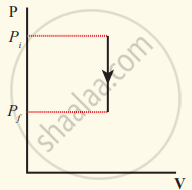Advertisements
Advertisements
प्रश्न
Explain in detail the isochoric process.
उत्तर
Isochoric process: This is a thermodynamic process in which the volume of the system is kept constant. But pressure, temperature and internal energy continue to be variables.
The pressure-volume graph for an isochoric process is a vertical line parallel to the pressure axis as shown in Figure.

Isochoric process with increased pressure

Isochoric process with decreased pressure

Isochoric process
P = `((μ"R")/"V")"T"` ...............(1)
where `((μ"R")/"V")` = constant
We can infer that the pressure is directly proportional to temperature. This implies that the P-T graph for an isochoric process is a straight line passing through the origin. If gas goes from the state (Pi, Ti) to (Pf, Tf) at constant volume, then the system satisfies the following equation
`"P"_"i"/"T"_"i" = "P"_"f"/"T"_"f"` .....,,,(2)
For an isochoric processes, ∆V = 0 and W = 0. Then the first law becomes
∆U = 0 .................(3)
Implying that the heat supplied is used to increase only the internal energy. As a result the temperature increases and pressure also increases.
Suppose a system loses heat to the surroundings through conducting walls by keeping the volume constant, then its internal energy decreases. As a result the temperature decreases; the pressure also decreases.
APPEARS IN
संबंधित प्रश्न
Answer in brief.
Why should a Carnot cycle have two isothermal two adiabatic processes?
Write a note on free expansion.
Explain the thermodynamics of the isochoric process.
When food is cooked in a vessel by keeping the lid closed, after some time the steam pushes the lid outward. By considering the steam as a thermodynamic system, then in the cooking process
Apply first law for an isobaric process.
Give the equation of state for an adiabatic process.
Give an equation state for an isochoric process.
In a petrol engine, (internal combustion engine) air at atmospheric pressure and temperature of 20°C is compressed in the cylinder by the piston to `1/8` of its original volume. Calculate the temperature of the compressed air. (For air γ = 1.4)
A monoatomic gas of pressure p having volume V expands isothermally to a volume 2V and then adiabatically to a volume 16V. The final pressure of the gas is ____________.
`("ratio of specific heats" = 5/3)`
Ideal gas for which 'ϒ' = 1.5 is suddenly compressed to `1/4`th of its initial volume. The ratio of 4 the final pressure to the initial pressure is ______.
`(ϒ = "C"_"p"/"C"_"v")`
